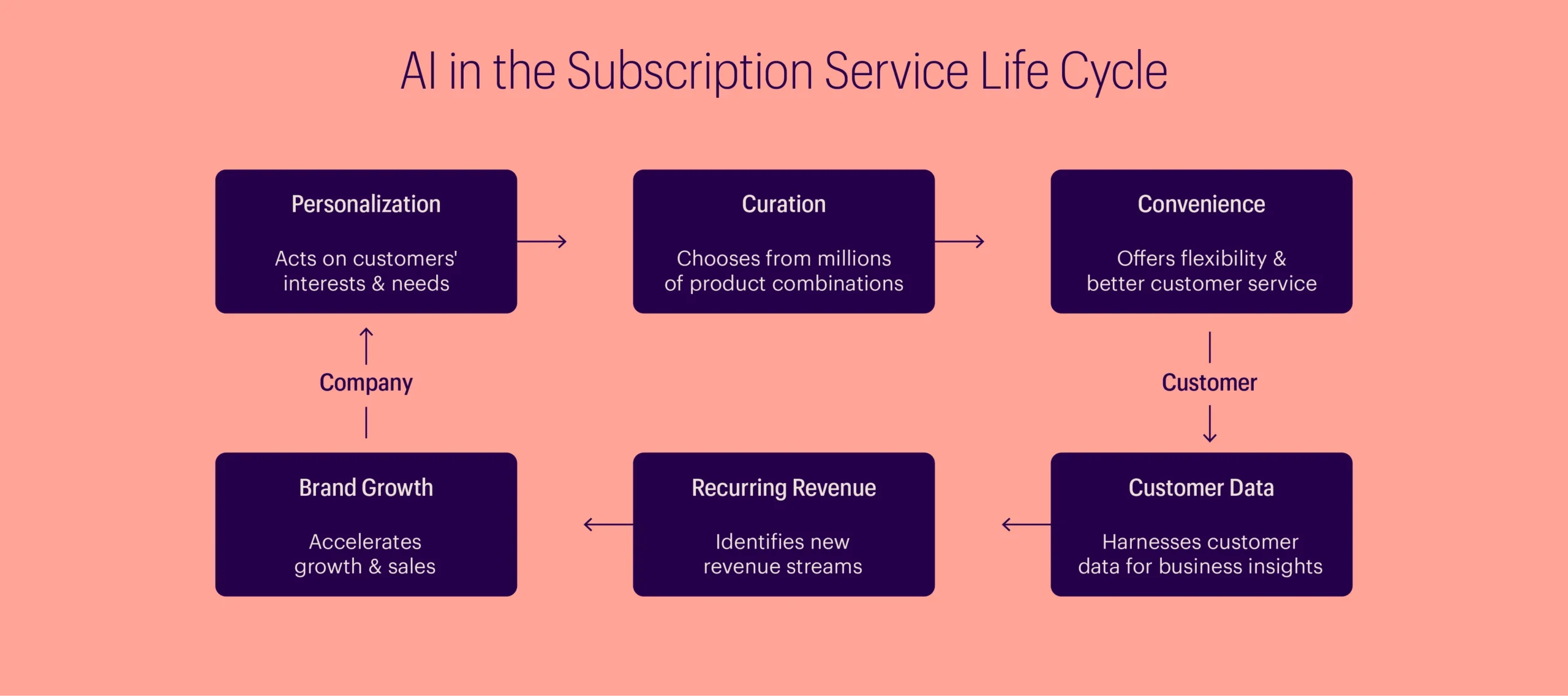‘Subscription’ has steadily become a buzzword across industries and verticals in the past few years, with players in sectors such as technology, music, CPG goods, fashion, automobiles, and news innovating to offer unique subscription services. As consumer preferences across the globe see a monumental shift in favor of affordable, flexible, and convenient shopping experiences, the subscription services economy is set to see even greater growth.
Several industry giants have already tapped into this rich source of customer data, and businesses across North America, Europe, and Asia Pacific have seen subscription-based sales increase by more than 300% in the past seven years.[1] The boom in this market has further been accelerated by the pandemic—with growing expectations among customers on doorstep delivery of products, companies are increasingly turning to AI to streamline outreach methods and elevate CX.
Bolstering personalization and digitalization:
While personalization is crucial to achieving customer satisfaction, traditional methods are time consuming and cannot be practiced at scale. This is where analytics offers immediate advantages for subscription services: data-driven insights into customer behavior, including the types of services they look for, products they find useful, and their interests, can be quickly leveraged to map customers to relevant products. Analyzing customer clicks, scrolling, page views, and even social media activity can offer in-depth and real-time feedback on their preferences and needs.
In the context of sales, analytics can also facilitate highly personalized product recommendations, upselling, and cross-selling opportunities. Moreover, using AI, data on the latest market trends can be incorporated into product design and curation, and millions of product combinations can be selected from to directly appeal to each individual. A major clothing subscription service has even gone one step beyond, automating client profiling, warehouse assignment, inventory stocking, and ticketing, thus allowing their staff to focus on consistent communication and offering highly personalized CX.[2]
AI can further help businesses develop dynamic pricing models, custom subscription plans, and offer a range of convenient pricing options to customers, reinforcing the exclusivity of the service as well as maintaining convenience as a USP.
Navigating the subscription economy:
Several businesses have forayed into subscription retail to bolster relevance using DTC approaches and also forge strong brand reputations through quality products and services. However, the decision to develop a subscription service—whether to create a new one from the ground up, pivot into the subscription space, prioritize one channel of sales over others, or diversify and differentiate existing services—must be backed by extensive research to ensure optimal ROI. For example, a major entertainment subscription service has used pivoting-on-the-go as one of its core strategies, evolving from a DVD-by-mail service and subscription model to a streaming service and TV network using the power of analytics.[3]
Data-driven market research can help examine the viability of existing products as the focus of subscription services as well as the need to develop entirely new products, based on market trends and customer preferences. Moreover, the massive amounts of historical data available across sources can further be analyzed using AI to help identify granular trends and market patterns that may otherwise go unnoticed—opening up the possibilities of tapping into emerging customer segments, foreseeing disruptive events, and capitalizing on unique trends.
Through insights derived from real-time feedback and predictive analyses, data can also enable businesses to scale up services, tap into new distribution channels, and diversify as necessary. For instance, several automotive players have moved into the subscription market space in the past few years, with vehicle subscription services’ valuation expected to cross $40 billion by 2026.[4] One of the factors prompting this shift is the emergence of younger demographics, who prefer car sharing to car ownership, and low-commitment to high-commitment purchases. In examining and responding to these shifts in the market, automotive players are now offering bundled services, including insurance and maintenance, for a flat monthly fee.[5]
AI-powered insights can also help leverage approaches that several subscription services have already benefitted from, including minimizing startup costs, eliminating middlemen, ensuring recurring revenue streams, scaling up rapidly,[6] and correlating subscription offerings to existing product lines to improve revenue on all fronts.
In addition, an important metric that can help businesses gauge the health of their subscription service is the LTV/CAC ratio—lifetime value of the customer/customer acquisition cost. This ratio allows executives to measure the impact of customer acquisition on long-term profits, which becomes important in situations where business decisions and investments do not see immediate payoffs. It also enables comparisons between a business’s performance and that of competitors as well as the comparison of different internal functions’ performance, helping quantify value creation. Such a data-driven approach can help prioritize investments across portfolios and operations, identify areas of low impact, and inform decision-making on growth and profits—making it a highly relevant advantage for subscription services across markets.

Optimizing marketing efforts:
The success of several subscription services has been traced back to timely marketing efforts. Reaching out to consumers on high-impact platforms, getting the messaging right, and ensuring tailored communication have been key to driving the popularity of subscription retail. As the volume of marketing communication across services has multiplied exponentially, communication fatigue has become a major problem across demographics. Here, data-based insights into customer preferences can drive hyper-targeted marketing efforts, including emails, text messages, and social media posts, to ensure dynamic and relevant messaging across platforms.
AI can also help identify communication channels that will prove effective for subscription services, including word-of-mouth recommendations and online reviews,[7] to directly impact sign-up rates. With effective content choice and placement, product visibility can receive a boost. AI can also help zero in on the right message to help differentiate a business among a sea of subscription services, especially in markets where consumers are likely to have multiple active subscriptions at once. Moreover, feedback channels, including AI-enabled chatbots, can be used to foster customer engagement, retention, and derive rich information on product/service performance.
Reducing customer churn:
High rates of customer churn continue to be a major pain point for subscription services across industries. Recent research on consumer-oriented subscription services estimated an average 7.2% monthly rate of churn, with the rate climbing to 10% for consumer goods-based subscription services.[8]
Customer attrition is impacted by several factors, including service under-utilization, poor customer satisfaction, dips in product/service quality, lack of perceived value and product relevance, and unattractive pricing. In such cases, churn analytics can be applied to data sourced from various platforms to assess risks. Thereafter, well-timed strategies to reinforce product relevance and a high level of customer service can be implemented. Customer acquisition and retention rates also become an important part of the equation—studying historical data can help develop sound customer acquisition practices, including trial services, discounts, and upgrades. Data can also drive customer retention by helping develop the right incentivization offers.
According to a report, only 55% percent of people considering a service ultimately subscribe to it, making customer commitment and a sustainable experience essential to subscription services. AI therefore offers several avenues of understanding and quantifying the factors associated with customer churn, minimizing costs, and maximizing impact to ensure value creation for businesses.
As subscription services across industries continue to see phenomenal growth, analytics is poised to become a mainstay in the subscription space, helping reinforce and improve the key elements that subscription services pivot on: convenience, scale, personalization, and unique offerings in the market.
Bibliography:
[1]. Rogers, Mike. “Real-Time Payments: The Future for Subscriptions.” Subscription Insider, December 16, 2020.
https://www.subscriptioninsider.com/topics/payment-processing/real-time-recurring-payments-processing.
[2]. “Stitch Fix Algorithms Tour.” Stitch Fix, n.d.
https://algorithms-tour.stitchfix.com/#client-experience-part-1.
[3]. Srivastava, Rajendra, and Piyush Sharma. “Subscription as a Service: The Netflix Playbook.” Fortune India: Business News, Strategy, Finance and Corporate Insight, January 6, 2020.
https://www.fortuneindia.com/opinion/subscription-as-a-service-the-netflix-playbook/103966.
[4]. Global Market Insights Inc. “Automotive Subscription Services Market to Hit USD 40 Bn by 2026: Global Market Insights, Inc..” GlobeNewswire News Room, November 4, 2020.
https://www.globenewswire.com/news-release/2020/11/04/2119870/0/en/Automotive-Subscription-Services-Market-to-hit-USD-40-Bn-by-2026-Global-Market-Insights-Inc.html.
[5]. “Care by Volvo I the All-Inclusive Car Subscription.” Care by Volvo I The all-inclusive car subscription, n.d.
https://www.volvocars.com/us/care-by-volvo.
[6]. Foscht, Thomas, Jay I. Sinha, and Thomas T. Fung. “How Analytics and Ai Are Driving the Subscription E-Commerce Phenomenon.” MIT Sloan Management Review, December 6, 2016.
https://sloanreview.mit.edu/article/using-analytics-and-ai-subscription-e-commerce-has-personalized-marketing-all-boxed-up.
[7]. Chen, Tony, Ken Fenyo, Sylvia Yang, and Jessica Zhang. “Thinking inside the Subscription Box: New Research on e-Commerce Consumers.” McKinsey & Company, February 9, 2018.
https://www.mckinsey.com/industries/technology-media-and-telecommunications/our-insights/thinking-inside-the-subscription-box-new-research-on-ecommerce-consumers.
[8]. “Annual Subscription Billing Metrics Report: Recurly.” Recurly, Inc., n.d.
https://recurly.com/research/annual-subscription-billling-metrics-report/?submissionGuid=3c21cde7-5f58-4d86-9218-332d697e7b3e.
